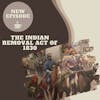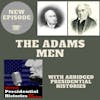Millard Fillmore

Join me this week as I dive into the life and career of Millard Fillmore.
The second "accidental president," Fillmore ascended to the office after the passing of Zachary Taylor. The two men, who had no relationship before Taylor's death, proved to have very different opinions on the issue of the day.
Fillmore is considered by many to be one of the worst presidents in history. Tune in to find out why.
Fillmore, Millard. “December 2, 1850: First Annual Message.” The Miller Center. (LINK)
Finkelman, Paul. Millard Fillmore: The American Presidents Series: The 13th President, 1850-1853. United States: Henry Holt and Company, 2011.
Holt, Michael. “Millard Fillmore: Campaigns and Elections.” The Miller Center. (LINK)
“Millard Fillmore.” The White House Historical Association. (LINK)
“All mutual concession in the nature of a compromise must necessarily be unwelcome to men of extreme opinions.And though without such concessions our Constitution could not have been formed, and can not be permanently sustained, yet we have seen them made the subject of bitter controversy in both sections of the Republic.” Millard Fillmore, December 2, 1850.
Welcome to Civics and Coffee. My name is Alycia and I am a self-professed history nerd. Each week, I am going to chat about a topic on U.S history and give you both the highlights and occasionally break down some of the complexities in history; and share stories you may not remember learning in high school. All in the time it takes to enjoy a cup of coffee.
INTRO MUSIC
Hey everyone. Welcome back.
For the second time in under a decade, the country faced political chaos as 12th president Zachary Taylor passed away a mere sixteen months into his presidential administration. The war hero, who had ridden to presidential victory on the coattails of his military might, died in the middle of contentious debates in Congress over how the nation should handle recent land acquisitions from the Mexican American War.
While presidential succession had not yet been formally adopted, Taylor’s cabinet and members of Congress prepared themselves for what they felt was an inevitability - the ascension of former representative and current Vice President Millard Fillmore.
A man who had no relationship with Taylor before coming into office, and little contact with the administration while serving as Vice President, Fillmore took the reigns of office and vigorously pursued a course of action that was antagonistic to many. So just who was Millard Fillmore?
Grab your cup of coffee, peeps. Let’s do this.
Born in the fingerlakes region of New York on January 7, 1800, Millard Fillmore was one of eight children, and the first born son to his parents Nathaniel and Pheobe. His odd first name comes from his mother’s side, which was her maiden name prior to her marriage to Nathaniel. Naming children after maiden names was apparently a common practice amongst New Englanders and Millard continued the tradition upon having his own son later in life.
The family was incredibly poor and Millard received a rudimentary education. His father, believing he needed to learn a trade, set Fillmore up as an apprentice with a cloth maker, a position the young man hated. Described by some historians as akin to slavery, Millard made very little during his apprenticeship and longed to be free of the agreement. Sources vary on exactly how Fillmore got himself out of the job - one article I read stated he took out a loan, while his biographer Paul Finkleman contends Millard saved enough money from his paltry earnings to buy his way of the apprenticeship. Either way, Fillmore soon freed himself of the drudgery that was cloth making, committed to enhancing his education.
Millard was hypersensitive about his lack of traditional education and it was something that remained with him throughout his life. So dedicated to increasing his knowledge that he even saved money to purchase a dictionary, studying it when he got a free moment during his apprenticeship and at 17, paid to join a lending library. He also enrolled in a school in a nearby town, the New Hope Academy, where he met his future wife, Abigail.
The senior Fillmore was apparently so impressed with his son’s dedication to education that he helped secure Millard a clerkship with a local judge to help him study law. Working for Judge Wood proved to be a frustrating experience for Fillmore, who wanted to establish himself as an attorney and earn enough of a living to support himself and family. In a brash move, Fillmore took a case without the Judge’s knowledge, further fraying their relationship. When called out on his actions, Millard grew angry and left his clerkship, and moved to Buffalo where he hoped to find another attorney with whom he could study the law. His move proved the right choice as the lawyers he worked with in his new city were so impressed with his dedication to the material they allowed him to enter the bar early at just 23 years old.
Upon completing his legal studies, Fillmore was offered a position with a major Buffalo law firm, but decided to strike it out on his own. While this likely caused a delay in his earning power, it allowed Fillmore to be his own boss, something he likely yearned for after spending so much time under the command of others. He eventually secured enough economic freedom that he felt comfortable enough to get married, finally marrying Abigail Powers in 1826. The two welcomed a son two years later in 1828, followed by their daughter Mary in 1832.
Millard carried an interest in politics and successfully served in the New York State Assembly as a member of the Anti-Masonic Party in 1829. He served for three terms before running for the House of Representatives in 1832. Fillmore and other Anti-Mason’s decided the foundation of the Anti-Masons was much too narrow to successfully build a national coalition and therefore established the Whig party, which eventually attracted a combination of Anti-Masons, National Republicans, and Democrats unhappy with the state of the party. During his time in the house, Fillmore focused on further expanding local improvements such as the Buffalo harbor. He had a brief break in between his House of Representatives tenure, from 1834 to 1836. However, by 1836, Fillmore was again sent back to the House where he served until 1843.
In 1844, the Whigs hoped to launch Henry Clay as their candidate for President. There were some in the party who felt Millard would be a solid choice as Vice President. However others, including party boss Thurlow Weed, preferred Fillmore in the governor’s chair for New York. But, despite their best efforts, Fillmore was defeated in the governor’s race, losing to the Democratic candidate Silas Wright. While he was likely unhappy with the state of political career, Millard refocused his attention on his private life and invested his time in establishing a university in Buffalo, briefly serving as the first chancellor. However, politics came calling again and in 1848, Millard Fillmore became New York’s comptroller, winning his seat in a landslide by nearly 40,000 votes.
However, he would not remain in the office long. 1848 was yet another presidential election year and this time Fillmore would make the cut as the right choice for Vice President. The Whigs had narrowed in on military hero Zachary Taylor as their choice for the role of chief executive given his fame over his role in the victory over Mexico. Taylor, a slaveholding general from Louisiana, appeared to be everything southern citizens could dream of. Hailing from New York and a man who opposed slavery in principle, Fillmore provided the much needed balance to the ticket, appeasing voters in the north. Despite this being an apparent dynamic duo, the two men had never met, however Taylor apparently promised Fillmore a robust and influential role in his administration. Unfortunately, this would not come to fruition.
Once in office, party leaders jockeyed and schemed, leaving Millard without much authority. Even patronage appointments were outside of his purview, as Thurlow Weed and William Seward worked behind Fillmore’s back to build an alliance directly with Taylor and his cabinet. Thus, the Vice President spent his time focused on overseeing the Smithsonian Institution and monitoring the debates in the Senate, which grew increasingly contentious over the issue of slavery and whether to maintain the compromise of 1820 limiting its spread into the newly acquired territory.
Hoping to be the great compromiser once again, Henry Clay had introduced an omnibus bill he believed solved all of the major disagreements between the pro and anti slavery wings of congress. However, the bill seemed to stall in the chamber, as Clay was unable to secure agreement of enough members to pass the bill in its entirety. And from his position in the White House, Taylor indicated he was not supportive of the compromise and continued to push for immediate statehood for California and New Mexico.
Seemingly at a standstill, Stephen Douglass of Illinois stepped up and tried a different approach. Instead of passing one massive bill encompassing all of the compromises, Douglass decided to break it apart into several smaller bills. One bill addressed California statehood, another outlawed slave trading in the nation’s capital and each had just enough votes to pass. Watching from his seat as president of the Senate, Millard Fillmore supported the compromise and indicated to Taylor that should the vote come to a tie in the senate, he would vote in favor of it. The two did not have time to debate the issue as Taylor passed away on July 9th, 1850, elevating his Vice President into the top position.
It was the second time in under a decade that the nation had to deal with the loss of the chief executive, however this time Congress was better prepared. Upon hearing of the president’s death, Fillmore took the oath of office in private and immediately got to work. The cabinet, filled with Taylor supporters, resigned their appointments, fully expecting to be invited to stay on. However the new president, wanting to make a name for himself and likely feeling jilted over being left out of the administration, accepted their resignations and refused to continue their appointments. To date, Fillmore is the only quote unquote accidental president to remove his predecessor’s entire cabinet immediately.
Fillmore quickly went to work signing the series of compromise bills, believing wholeheartedly that compromise was the only way to address the slavery question. However, his support of these measures only angered both sides of the political spectrum with northern voters feeling like the president was placating the south and southern residents feeling the compromises did not go far enough in securing their way of life. In writing a biography of the former president, historian Paul Finkelman notes quote: “this total appeasement of the south only encouraged new demands for more land for slavery,” end quote. In an odd series of events, the new president decided to lean heavily into the newly passed Fugitive Slave bill, vigorously enforcing the law that required citizens throughout the country to assist in the recapture of suspected runaway slaves. Fillmore went so far as to push for treason charges for forty individuals who violated the law, only for the case to be thrown out by a supreme court judge.
While the country remained fiercely divided on the issue of slavery, Fillmore worked to implement his vision for the future of the nation. He began exploring ways to open up Japan to trade, and intervened against French and English attempts to annex Hawaii. He also sought to increase the nation's influence in Central America despite the previously signed Clayton-Bulwer Treaty, including dispatching warships to protect merchant vessels. Fillmore was also blamed for unsuccessful and unauthorized attempts at overthrowing Spanish rule on the island of Cuba as many saw the attempted coup as yet another overreach by southern slaveholders looking to expand their practice.
As the 1852 election drew near, Fillmore seemed ambivalent about reelection. His friend and secretary of state Daniel Webster had long wished to be president and Fillmore wanted to be respectful of the longtime civil servant’s career aspirations. However, Webster was over 70 and so the president hedged his bets, allowing his name to go forward at the Whig convention in June of 1852. Neither Fillmore nor Webster were selected, as the party picked yet another military man, this time General Winfield Scott. Fillmore would be the last president to serve as a member of the Whig Party, as the presidency went to Democratic candidate Franklin Pierce.
Fillmore lost both his wife and daughter shortly after leaving the White House and busied himself with his legal career. He tried once more for national office in 1856, this time running on the American, or Know Nothing Party platform. The party was nativist in nature and highly anti-catholic. While they tried to cultivate support by championing a populist message, Fillmore would secure only 21% of the vote and would lose to Democrat James Buchanan. With his loss, Fillmore joined a group of men who were denied re-election. Between Andrew Jackson in 1837 and Abraham Lincoln in 1864, no president successfully won a second term in office, further highlighting how fractured the country was becoming over the issue of slavery.
With his political career behind him, Fillmore rededicated his focus to his law practice before remarrying in 1858. His second wife, Caroline McIntosh, was quite well off and their combined wealth allowed Fillmore more freedom to entertain friends and get involved in charitable causes. As Civil War broke out after the election of Abraham Lincoln in 1860, Fillmore supported the union and led an all volunteer military force. And while he initially seemed in support of Lincoln and his administration, by the time it came to cast a vote in the 1864 election, the former president threw his support to democratic challenger George McClellan. And when Lincoln was assassinated in 1865, Fillmore’s house was smeared in black paint, apparently for his refusal to join the nation in adorning his house in black bunting. However, this doesn’t appear to be an intentional slight on Fillmore’s part as the former president was out of town.
The retired politician kept a pace of the happenings in the capital, and was supportive of new president Andrew Johnson’s reconstruction policies, believing them a necessary step in repairing the country. He spent his remaining retirement as a prominent citizen of Buffalo, continuing to support various causes before suffering a series of strokes in February and March of 1874, finally passing away on March 8.
Unlike the nationwide mourning experienced with the loss of presidents like Andrew Jackson and Abraham Lincoln, Millard Fillmore’s death went relatively unnoticed. Some historians attribute this to the president’s decision to vigorously enforce the fugitive slave law while in office, while others attribute it to the politician’s actions post-presidency. A self-made man who had a proclivity for strange political movements based on ethnic hatred, Millard Fillmore represented the people he served. He was a man who believed in principle that slavery was wrong, but felt powerless to stop it and that compromise was the best solution. His commitment to compromise earned him no favors and ultimately helped relegate him to the footnotes of history.
Despite his short sighted vision on domestic fronts, the thirteenth president of the United States navigated foreign affairs fairly successfully, and put the country on the road to a successful relationship with Japan. set the country up for some international wins that would not be achieved until after his administration. While he missed the mark with the attempted overthrow of Cuba, Fillmore had success in combating foreign influence in Central America and Hawaii.
As historian and Fillmore biographer Paul Finkelman argues, quote: “in the end, Fillmore was always on the wrong side of the great moral and political issues of the age,” end quote. His inability to see the divisiveness of slavery, his tendency toward conspiracy theories, and his sensitivity about his lack of education meant Millard Fillmore was perhaps always destined to be viewed as one of the worst presidents in history. However, given the state of the nation in the time period, perhaps Fillmore has been judged too harshly. As historian Michael Holt wrote, Millard Fillmore was one of many presidents who quote “were simply prey for the most heated American social debate of the nineteenth century,” end quote.
If you’ve been enjoying the podcast, please consider a rate and review. Spotify, podchaser, good pods, the places are seemingly endless. And if you ever want me to cover a topic, just let me know. You can reach me on all the socials or through the website at www dot civics and coffee dot com. The website is also where you can see source material and transcripts, and get your very own civics and coffee merch.
Thanks, peeps. I’ll see you next week.
Thanks for tuning and I hope you enjoyed this episode of Civics & Coffee. If you want to hear more small snippets from american history, be sure to subscribe wherever you get your podcasts. Thanks for listening and I look forward to our next cup of coffee together.
OUTRO MUSIC
Listener Favorites
Not sure where to begin? Take a listen to some fan favorites.

























